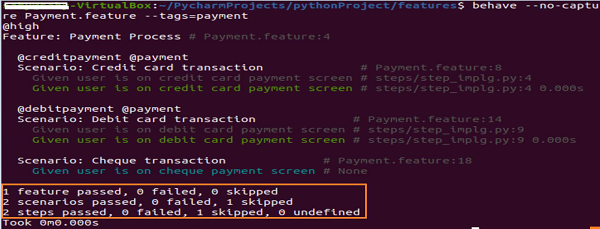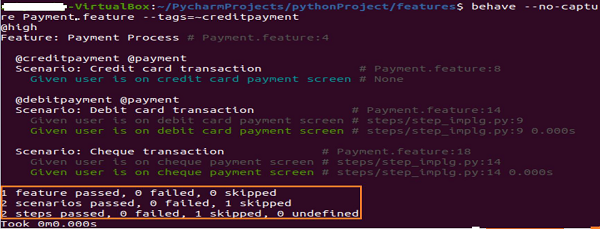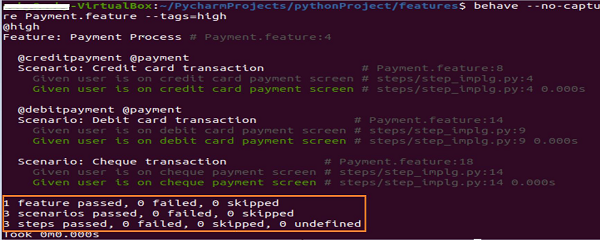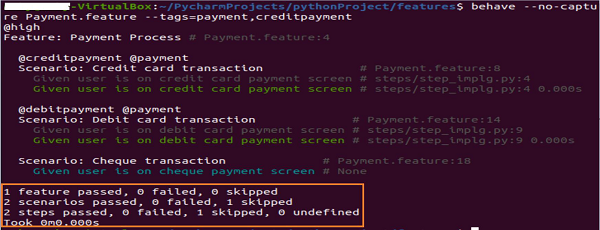
- Behave - Home
- Behave - Introduction
- Behave - Installation
- Behave - Command Line
- Behave - Configuration Files
- Behave - Feature Testing Setup
- Behave - Gherkin Keywords
- Behave - Feature Files
- Behave - Step Implementations
- Behave - First Steps
- Behave - Supported Languages
- Behave - Step Parameters
- Behave - Scenario Outlines
- Behave - Multiline Text
- Behave - Setup Table
- Behave - Steps in a Step
- Behave - Background
- Behave - Data Types
- Behave - Tags
- Behave - Enumeration
- Behave - Step Matchers
- Behave - Regular Expressions
- Behave - Optional Part
- Behave - Multi-Methods
- Behave - Step Functions
- Behave - Step Parameters
- Behave - Runner Script
- Behave - Exclude Tests
- Behave - Retry Mechanism
- Behave - Reports
- Behave - Hooks
- Behave - Debugging
- Behave Useful Resources
- Behave - Quick Guide
- Behave - Useful Resources
- Behave - Discussion
Behave - Tags
A section of a feature file can be tagged so that the Behave is capable of verifying only a certain section of the feature file. A Scenario, Feature, Scenario Outline can only be tagged.
Also, a tag which is used for a feature shall be inherited by all its Scenarios and the Scenario Outlines. Tags are placed before a Scenario or a Feature that we want to tag. We can also have multiple tags which are separated by spaces within a line.
A tag begins with @ and is followed by the tag name.
Feature File with tags (Payment.feature)
The feature file with tags is as follows −
@high
Feature − Payment Process
@creditpayment
Scenario − Credit card transaction
Given user is on credit card payment screen
Then user should be able to complete credit card payment
@debitpayment
Scenario − Debit card transaction
Given user is on debit card payment screen
Then user should be able to complete debit card payment
Tags help to manage the test execution by excluding/including the specific scenarios or features depending on the tag.
In the above example, to run a specific scenario with tag creditpayment, we have to run the below mentioned command −
behave payment.feature --tags=creditpayment
To run the feature with tag high and execute all the Scenarios, we have to run the following command −
behave payment.feature --tags=high
If run the command stated below, it means that the command shall execute the Scenarios which are tagged with creditpayment or debitpayment.
behave payment.feature --tags= creditpayment, debitpayment
If run the command given below, it means that the command shall execute both the Scenarios which are tagged with creditpayment and debitpayment.
behave payment.feature --tags= creditpayment --tags=debitpayment
If run the command mentioned below, it means that the command shall not execute the Scenario which is tagged with creditpayment.
behave payment.feature --tags= ~ creditpayment
Hence, the Feature File with tags(Payment.feature) will now be as follows −
@high
Feature − Payment Process
@creditpayment @payment
Scenario − Credit card transaction
Given user is on credit card payment screen
@debitpayment @payment
Scenario − Debit card transaction
Given user is on debit card payment screen
Scenario − Cheque transaction
Given user is on cheque payment screen
Corresponding Step Implementation File
The file is as follows −
from behave import *
@given('user is on credit card payment screen')
def credit_card_pay(context):
print('User is on credit card payment screen')
@given('user is on debit card payment screen')
def debit_card_pay(context):
print('user is on debit card payment screen')
@given('user is on cheque payment screen')
def cheque_pay(context):
print('user is on cheque payment screen')
Output
The output obtained after running the feature file is mentioned below. Here, we have used the command behave --no-capture Payment.feature --tags=payment.

The output shows two scenarios passed, as there are two Scenarios in the features file having Scenario tag with payment.
When we use the command behave --no-capture Payment.feature --tags=~creditpayment, the output is as follows −

The output shows two scenarios passed, as there are two Scenarios in the features file not having Scenario tag with creditpayment.
When we use the command behave --no-capture Payment.feature --tags=high, the output is given below −

The output shows three scenarios passed, as there are three Scenarios in the features file not having features tagged with high.
Use the command behave --no-capture Payment.feature --tags=payment,creditpayment to get the below mentioned output −

The output shows two scenarios passed, as there are two Scenarios in the features file not having Scenario tagged with payment or creditpayment.